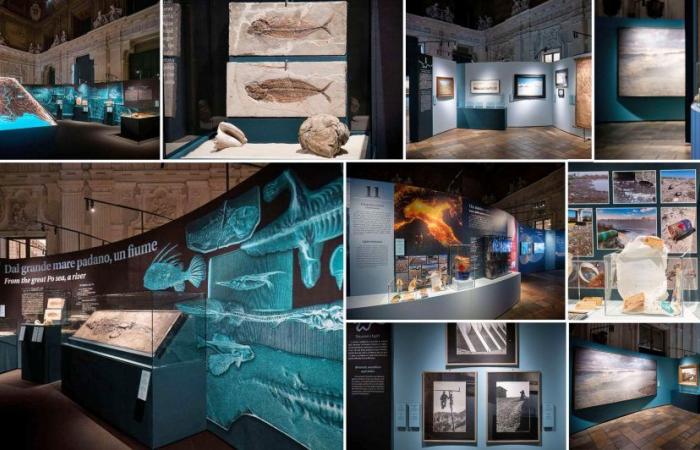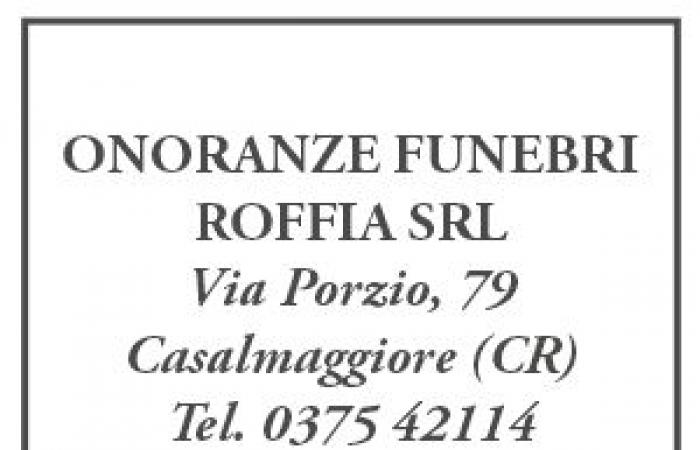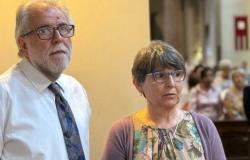Under the High Patronage of the President of the Republic, Palazzo Madama – Museo Civico d’Arte Antica di Torino presents an exhibition that, together with a very broad territorial project, intends to explore the theme of the climate crisis, offering a synoptic vision of the millennial changes along the path of the Po River, a paradigm of what is happening on a global scale.
The project was born in dialogue with the Department of City Care, Public Greenery and River Banks of the City of Turin and from the collaboration between Palazzo Madama and key national partners, who have always been committed to the issues of environmental conservation and protection, first and foremost the Po River District Basin Authority (ABDPO) and the Interregional Agency for the Po River (AIPo) together with the Po Biosphere Reserves, now united in the UNESCO Po Grande MaB Reserve. Alongside them, the Turin interpreters, from the Polytechnic of Turin to the University of Turin, to the European Research Institute who daily carry out research and study of the Po and water in general from different disciplinary perspectives, and with the media partnership of Rai Radio3.
Addressing the essential themes of climate change in an exhibition that weaves a visual story entirely developed in the interaction between great painting and photography, illustration and infographics capable of narrating the Italian landscape in its complexity and articulation, from the Alps to the sea, the exhibition project focuses attention on the theme of water and in particular on our Great River, which for millennia has determined the landscape and the life of the population, is a means of communication but also an essential support for agricultural and industrial activities, and explores the consequences and analyses the potential solutions put in place.
act on the territory by the various research and protection bodies of the Po.
652 kilometers long, 141 tributaries, almost 87,000 square kilometers of hydrographic basin, 19,850,000 inhabitants, 37% of Italian agricultural production, 55% of the national livestock industry: the Po and the Po Valley, where 40% of the national GDP is produced, constitute one of the areas with the highest concentration of population, industries and commercial activities at European level.
This incredible development has been made possible thanks to the historical stability and abundance of the flow of waters of the largest river in Italy, which come from countless sources and diversified natural processes – mountain springs, snow melt, glaciers, large lakes and plain resurgences – but which in recent decades have seen a significant change, leading to a crisis phenomenon that is occurring everywhere on a global level.
Precisely because of its peculiarities and its legacy of memory, historical stratification and landscapes, the Po – Roman and pagan, Byzantine and Lombard, feudal and of the lordships, of the countryside and of the cities, romantic, agricultural, industrial, touristic and cinematographic – is capable of conveying in an emblematic and clearly perceptible way the climate crisis and its effects: the physiognomy of the planet is changing more rapidly than it has done in the last millennia and the role that human beings have played in this process is now demonstrated.
The Change! exhibition aims to describe these changes, offering opportunities for reflection on the crisis and possible scenarios for adapting to it, but also to encourage action and awareness: it is time to act.
With a strong scenographic and emotional impact, thanks to the exhibition design by Emilio Alberti e Mauro Zocchettathe exhibition opens with a formidable installation capable of projecting onto the landscape of ten million years ago, then narrated through the world of fossils, astonishing historical maps, infographics and original illustrations created by Jacopo Rosati, starting a story on the birth, history and evolution of the Po Basin first and of the Po to follow, with a focus on the changes characterised by a secular trend and a sudden acceleration during the Anthropocene, our era.
The second section illustrates natural life and human work in the Po basin area through photographs and paintings by great artists, some of which come from the collections of the Civic Museums of Turin, so as to underline the exceptional nature not only of the heritage of the GAM and Palazzo Madama, but also of the funds
historians of the Photographic Archive: oils, watercolours, etchings and tempera by John Michael Graneri, Jean Louis Daudet, Giuseppe Pietro Bagetti, Charles Pittara, Giuseppe Pelizza from Volpedo and other great artists will be placed next to photographs by masters such as Victor Sella, Mario Gabinio, Richard Moncalvo, Frank Fontana, Mimmo Jodice e Brown Biaminoto restore fragments of daily life, traditions, activities and relationships of the people who live along the banks of the Po River, as well as to outline the Po Valley landscapes through the centuries.
The third section is dedicated to the Anthropocene. Around 1950, the emission of large quantities of greenhouse gases reversed the neoglaciation process, generating a phase of anthropogenic climate warming, which is what the current drought of the Po tells us: the decrease in its flow, caused
from the thinning of the Alpine glaciers, causing a decrease in the water reaching the Delta.
The story told through images by Mondoserie.it is a crystalline example of the way in which man originally looked at the Earth and how this gaze has become progressively less farsighted, to the point of losing sight of the overall horizon which, however, now reveals itself with disruptive events. The shallows of the Po are the local symptom of a planetary problem, that of the reduction of glaciers and polar ice caps, told in the exhibition through satellite images that show the map of the Po river basin, with the hundreds of blue veins that descend from the Alpine and Apennine valleys to then reunite and give shape, in the Po Valley, to the g† xlarge blue trace of the Po which flows into the Adriatic.
A hydrographic network that appears as a set of “blood vessels” that ensure the territory the lifeblood of the water element, necessary for the very survival of the plant and animal world, and which, in recent years, has undergone radical changes: in some periods of the year the large river bed is reduced to piles of gravel and sand, colonized by bushes and young plants, the tributaries are dry and the delicate ecosystem of the Delta is put at risk by the rising salt wedge.
The Italian drought is however a unique case, because it derives from one of the many paradoxes that characterise our country: although Italy is fifth in Europe in terms of rainfall after Croatia, Ireland, Austria and Slovenia, we are the country that stores the least water overall, since we are unable to
to store it.
Faced with this scenario, it is necessary to imagine new solutions: mitigation and adaptation must include not only actions that contribute to reducing the vulnerability of human beings to the current (or expected) impacts of climate change, such as extreme weather events and sea level rise, but also new agricultural protocols that guarantee food security and compensate for the loss of biodiversity, as well as the production and supply of energy from alternative sources to existing ones, laying new foundations for a more balanced relationship between man and nature.
The images of Adaptation.it invite us to rediscover the ability to correct our own mistakes, to mitigate them, and the possibility for man to explore new solutions by giving space to his incredible ability to adapt to new, unexpected and often even unfavourable situations, exploiting inventiveness, tradition and
simple common sense.
The Change! exhibition is part of a larger project that Palazzo Madama is dedicating throughout 2024 to the themes of peoples’ rights and self-determination, climate and Europe and represents the culmination of a reflection that began in April with Planet Week together with the World Bank on the occasion of the G7 Climate,
Energy and Environment and developed through the exhibition Max Pinckers. State of Emergency and which will see the activation of a collateral exhibition Memorie d’acqua.
Words and images by the Italian Linguistic Atlas; cycles of international conferences and conventions organized by the District Basin Authority of
River Po, from the Department of City Care, Public Green and river banks of the City of Turin, together with a busy program of activities, workshops, laboratories and days at a reduced rate that will involve the entire citizenry, in the rediscovery and protection of the great water artery.
The exhibition, curated by Tiziana Caserta, Anna La Ferla and Giovanni CF Villa, will be accompanied by a catalogue, published by Silvana Editoriale, with contributions – among others – from scholars from the University of Turin, the University of Bergamo, the Polytechnic of Turin, the Polytechnic of Milan, ENEA, Slow Food, Adaptation.it and Mondoserie.it.
- USEFUL INFO:
EXHIBITION VENUE AND DATES Palazzo Madama – Civic Museum of Ancient Art. Piazza Castello, Turin - June 27, 2024 – January 13, 2025
- OPENING HOURS Monday and Wednesday to Sunday: 10am – 6pm. Closed on Tuesdays
Ticket service ends one hour before closing time - TICKETS full price €12.00 | reduced price €10.00
- Free Museum Pass and Torino+Piemonte card
- INFORMATION [email protected] – t. 011 4433501
- www.palazzomadamatorino.it
- Press Office Palazzo Madama – Turin Museums Foundation
Daniela Matteu | T +39 011 4429523 – M +39 348 7829162 @ [email protected]
Stefania Audisio | M +39 342 6266357 @ [email protected]
Chiara Vittone | M +39 340 3739197 @ [email protected]
© Reproduction reserved











